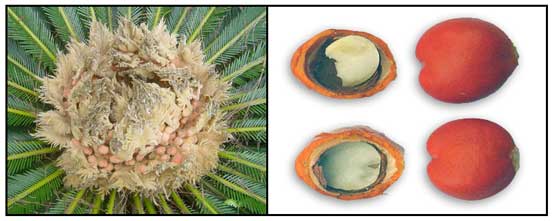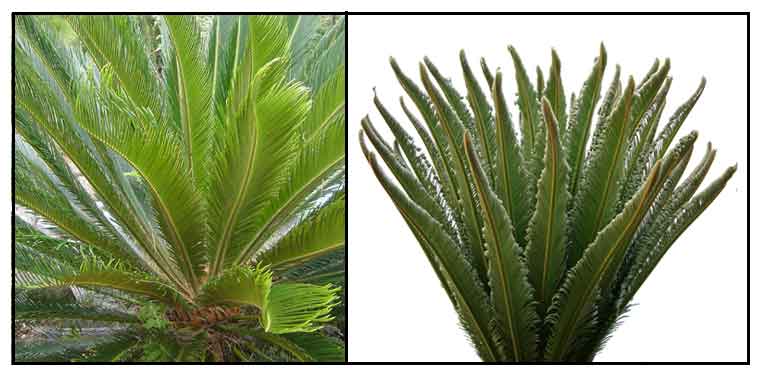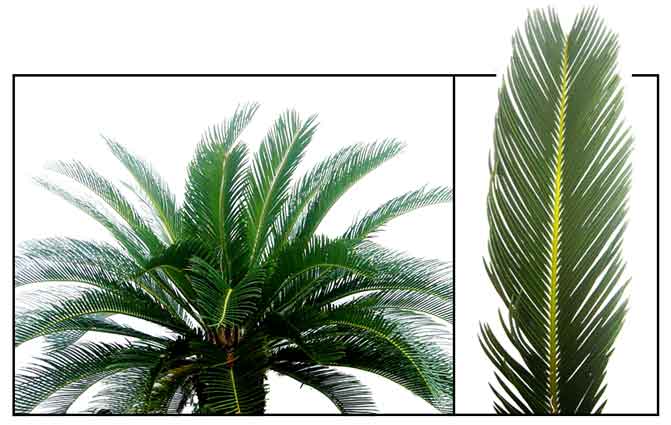Legend
Cycas revoluta has been called the "living fossil" because of its origin is traced all the way back to the ancient flora of early Mesozoic era, (200 million years ago).
Botany
Oliba is a cycad with a
stout and cylindric trunk marked with prominent scars, in the Philippines usually
not growing more than a meter in height, elsewhere reported to grow as high as 5 meters. Leaves are numerous,
crowded, spreading, 0.5 to 1.5 meters long. Leaflets are very numerous,
close, and linear; 18 centimeters long in the middle, 4 to 6 millimeters wide, the upper surface glabrous, the lower, hairy. Ovules
are hairy. Seeds are on loosely arranged leaves around the stem. Seeds are large, plum-like, and pale-yellow to tan.
 Distribution Distribution
- Introduced.
- Now, cultivated
for ornamental purposes.
- Native to Japan and southern China.
Constituents
• Many cycads are toxic
because the stems, leaves and seeds contain high amounts of cycasin
alkaloids, macrozamin or methylazoxymethanol. Both cycasin and macrozamin
are harmful to the liver; cycasin and methylazoxymethanol are neurotoxic
and carcinogenic.
• Japanese study isolated a novel leptin from the leaves of CR.
• Seeds have yielded B-N-methylamin-L-alanine (BMAA) used for
tonics and poultices.
• Study yielded a novel nonprotein amino acid, cycasindene.
• Cycad palms produce three toxins: cycasin, beta-methylamino-L-alanine, and an unidentified toxin. (see toxicity below)
• GC-MS analysis of essential oil extracted with petroleum ether yielded 5 components of fatty acids: Linolenic acid (18.47%), Oleic acid (12.96%), Linoleic acids (10.9%), Palmitic acid (8.82%) and Octadecanoic acid (7.85%). (22)
• Phytochemical analysis of ethyl acetate extract of leaves yielded five compounds including two new two new dihydroamentoflavone glucosides, (2S)-I-(2,3)-dihydro-I-7-O-β-d-glucopyranosylamentoflavone (1) and (2S)-I-(2,3)-dihydro-I-7,II-7-di-O-β-d-glucopyranosylamentoflavone (2), in addition to the known compounds prunin (3), vitexin-2″-rhamnoside (4) and protocatechuic acid (5). (see study below) (23)
Properties
• Seeds of Cycas
species reported to be toxic and carcinogenic.
• Terminal shoot considered astringent and diuretic.
• Seed considered emmenagogue, expectorant, tonic.
Parts utilized
Fruit, leaves, shoots, seeds.

Uses
Edibility
• Fleshy seeds, leaves, unprocessed flour from stem pith considered poisonous. Considered by some to be toxic only if consumed in large quantities.
• Seeds are widely consumed as food and medicine (as tonic or poultices) in southern Japan, the Chamorros of Guam, and the Auyu people of New Guinea, Australia, and the western Pacific Islands.
• Seeds are dried and ground into powder, and mixed with brown rice and fermented into "date miso" or "sotetsu miso."
Folkloric
• Like the palaspas, some albularyos have the leaves 'blessed'
on Palm Sunday and used for a variety of medicinal uses.
For suob, the leaves are dried and powdered, and added
to to the insenso kamanyan for the the ritual.
• In China, fruit used as expectorant
and tonic.
• Despite known toxicities, Cycad stems and seeds are used for
high blood pressure, headaches, congestion, rheumatism and bone pain.
• Leaves used in the treatment of cancer and hepatoma.
• Terminal shoots used as astringent and diuretic.
• In Japan's Kii Peninsula, a "tonic"
is made from the dried seeds of CR.
• In Bangladesh, the whole plant used for paralysis, indigestion, snake bites.
• In the Assam district of India, used for painful urination: a piece of young female cone eaten daily until cure. (17)
Others
• Palm Sunday: Leaves used for the ritual palms for Palm Sunday.

Studies
• Presence of aromatase inhibitors in cycads: Cycas revoluta was one of five
species of cycad folia studied for inhibition of cytochrome P-450 aromatase
for use in the treatment of estrogen-dependent tumors. All five test Cycas species were found to contain inhibitors of the human enzyme. (2)
• Lectin: Study isolated a novel lectin from the leaves of Cycas revoluta. The inhibition analysis of hemagglutinating activity and partial amino acid sequences of lysylendopeptic peptides show it to belong to the jacalin-related lectin family. (5)
• Leaves / Antimicrobial / Antioxidant: Hydroalcoholic extracts of leaves showed potent antimicrobial activity against E. coli, Klebsiella pneumoniae and Saccharomyces cerevisae. Extracts also showed antioxidant activity. (13)
• Peptide / Bactericidal / Proapoptotic / Seeds: Study purified a peptide from the seeds of Cycas revoluta. The peptide showed deleterious effects against human epidermoid cancer (Hep2) and colon carcinoma cells (HCT15), and caused inhibition of cancer cell proliferation and induced apoptosis by direct DNA binding. A remarkable bactericidal activity was also observed in the same peptide. (15)
• Antibacterial: In a pharmacologic study of selected plants, ethanol and ethanol extracts of C. revoluta showed antibacterial activity against E. coli, S. aureus, Pseudomonas, B. subtilis, Klebsiella and S. typhimurium. (16)
• Chitinase-A: Study purified chitinase-A (CrChi-A) from the leaf rachises of C. revoluta. It exhibited transglycosylation activity not previously observed in plant chitinases. Studies have suggested chitinases have roles in plant defenses and interactions with simbiotic microorganisms and developmental processes. (18)
• Antimicrobial / Leaves and Female Cones: Study screened C. revoluta for the isolation of a potent molecule responsible for antimicrobial potential against pathogenic and drug resistant strains. Study isolated a novel molecule, 2, 3-dihydro-4′-O-methyl-amentoflavone from the chloroform extract of leaves and female cones which promising antimicrobial activity against MRSA (methicillin resistant Staphyloccocus aureus), E. Coli, Salmonella abony, Aspergillus niger, Candida albicans, among others. (19)
• Antibacterial Biflavonoids / Leaves: Study of methanolic extract of leaflets of Cycas circinalis and chloroform extract Cycas revoluta yielded one new biflavonoid and 15 known compounds. Compounds 2, 6, and 18 exhibited moderate antibacterial activity against Staphylococcus aureus and MRSA. (20)
• Antimicrobial / Leaves and Cones: Study evaluated chloroformic and hydroalcoholic extracts of leaves and female cones of Cycas revoluta for antimicrobial potential. Results showed promising antimicrobial activity against methicillin resistant Staphylococcus aureus, Escherichia coli, Salmonella abony, Aspergillus niger, Candida albicans, among others. The chloroformic extract of cones showing more activity than the chloroformic extract of leaves. (21)
• Cytotoxic / Anti-Leishmanial / Antimicrobial / Leaves: Study of EA extract of leaves yielded two new dihydroamentoflavone glucosides, along with three known compounds. The EA extract showed weak cytotoxicity against HepG2. Compound 4, vitexin-2"-rhamnoside, showed significant activity against Leishmania donovani. The isolated compounds showed weak antimicrobial activity. (see constituents above) (23)
• Antioxidant / Leaves and Cones: Study investigated different solvent extracts of Cycas female cone and leaves for in vitro antioxidant activity. Results showed chloroform extracts of female cones showed more potent antioxidant activity followed by chloroformic extract of leaves. (24)
• Amentoflavones / Antioxidant / Cytotoxicity / Leaflets: Study of leaves isolated eight compounds. Compounds 5, 6, and 7 (amentoflavone, amentoflavone glucoside, neohesperidin) showed antioxidant activity nearly two to four folds higher than quercetin at dose of 12.5 µg/ml. Compound 6 NS 7 showed very strong cytotoxicity against MCF-7 cell line with IC50 of 5.12 and 4.73 µg/ml, respectively. The cytotoxic and antioxidant activities were likely due to the biflavonoid content. (25)
Toxicity
• Toxic / Caricinogenic: Seeds of Cycas
species reported to be toxic and carcinogenic. Many cycads are toxic
because the stems, leaves and seeds contain high amounts of cycasin
alkaloids, macrozamin or methylazoxymethanol. Both cycasin and macrozamin
are harmful to the liver; cycasin and methylazoxymethanol are neurotoxic
and carcinogenic.
• Cycasin / Toxins: Although all parts of the plant are toxic, it is the seed that contains the highest level of toxin cycasin. Cycasin causes gastrointestinal irritation with vomiting, diarrhea and may cause seizures, hepatotoxicity with jaundice, cirrhosis, ascites and liver failure. Other toxins are beta-methylamino-L-alanine and an unidentified toxin. Beta-methylamino-L-alanine is a neurotoxic amino acid known to cause ataxia in rat and neuro-manifestations in humans. The unidentified toxin may cause hind limb paralysis in cattle from CNS axonal degeneration. Besides the excitatory and putative neurotoxin BMAA, Cycas revoluta also yield o-N-oxalylornithine.
• Guam Disease: Beta-methylamino-L-alanine, a neurotoxic amino acid, causes ataxia in rats and is implicated in Guam disease with symptoms similar to Alzheimer, Parkinson, and Lou Gehrig (ALS) diseases.
• Livestock: In cattle, an unidentified toxin may cause hindlimb paralysis, with axonal degeneration the CNS.
Availability
Ornamental cultivation. |



 Distribution
Distribution 



